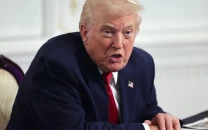The fuzzy math of the CPEC
Any inequity in CPEC's execution will detract from what should be the great equaliser for Pakistan’s political economy

Prime Minister Nawaz Sharif and Chinese President Xi Jinping inaugurate projects through video link in Islamabad on April 20, 2015. PHOTO: PID
Its first argument is that the area along the eastern route is the most developed and hence can be completed the fastest in order to meet China’s deadline for completion of at least one CPEC route. The work will no doubt be completed faster on this route, but when exactly does the government plan on rectifying the historical injustice of leaving the western provinces under-developed? If the argument is that Beijing’s funds must be allocated towards Beijing’s priorities, then what prevents Islamabad from using its own money towards building up infrastructure in K-P and Balochistan? If China is really providing so much money for the CPEC, then surely there must be room in the development budget to direct locally-raised taxpayer money to create a more balanced approach to the CPEC. The reality is something that the government does not want the people to know: most of the aid from China consists of commercial loans to private-sector Pakistani companies that are hiring Chinese firms to set up coal-fired power plants. Even the government aid consists mostly of loans. The CPEC is a worthwhile project, but any inequity will detract from what should be the great equaliser for Pakistan’s political economy.
Published in The Express Tribune, June 19th, 2015.
Like Opinion & Editorial on Facebook, follow @ETOpEd on Twitter to receive all updates on all our daily pieces.



















COMMENTS
Comments are moderated and generally will be posted if they are on-topic and not abusive.
For more information, please see our Comments FAQ